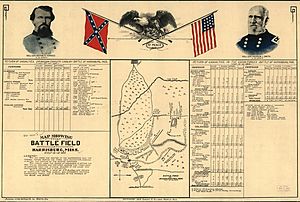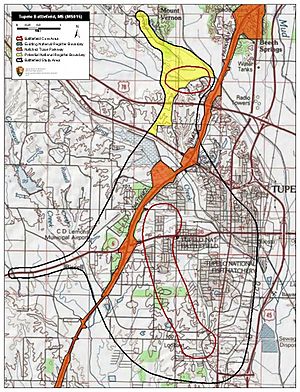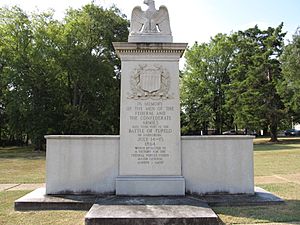Battle of Tupelo facts for kids
Quick facts for kids Battle of Tupelo |
|||||||
|---|---|---|---|---|---|---|---|
| Part of the Western Theater of the American Civil War | |||||||
 Battle of Tupelo (Battle of Harrisburg, Miss.) |
|||||||
|
|||||||
| Belligerents | |||||||
| Commanders and leaders | |||||||
|
|||||||
| Units involved | |||||||
| Right Wing, 16th Army Corps | Forrest's Cavalry | ||||||
| Strength | |||||||
| 13,000 infantry 3,000 cavalry 24 guns |
2,100 infantry 7,000 cavalry 20 guns |
||||||
| Casualties and losses | |||||||
| 69 dead and 533 wounded or missing | 215 dead and 1,125 wounded or missing | ||||||
The Battle of Tupelo was an important fight during the American Civil War. It happened from July 14 to 15, 1864, near Tupelo, Mississippi. This battle is also sometimes called the Engagement at Harrisburg. The Union army won against the Confederate forces. This victory helped keep the supply lines safe for General Sherman during his important Atlanta Campaign in Georgia.
Contents
Why Was the Battle of Tupelo Fought?
The year 1864 saw a lot of fighting in the Civil War. People in Mississippi were watching battles in Virginia and Georgia. But what happened in Mississippi was also very important.
Protecting Sherman's Supply Lines
Union General Sherman's army needed supplies. These supplies came by a single railroad line through Tennessee. Confederate generals like Lieutenant-General Stephen D. Lee and Major-General Nathan B. Forrest wanted to attack this railroad. If they destroyed it, Sherman's army would be in big trouble. The battles of Brice's Crossroads and Tupelo were fought to protect this vital Union supply line.
How Did the Battle of Tupelo Start?
Union Major-General Andrew J. Smith led his troops into north Mississippi. They started from La Grange, Tennessee, on July 5, 1864.
The Union Advance to Pontotoc
Smith's army moved in two groups. They didn't face much resistance at first. But as they got close to Pontotoc, Confederate Brigadier-General James R. Chalmers stopped their advance. Meanwhile, General Forrest was getting ready for a battle near Okolona. General Lee was also with the Confederate forces and took overall command.
Skirmishes and a Wagon Train Attack
Forrest's soldiers stopped the Union army three times on different roads. On July 12, both Union groups turned towards Tupelo. General Lee then moved with his divisions to attack Smith's side. General Forrest attacked the Union's rear. There was a running fight for ten miles. Neither side gained much advantage. However, Chalmers's brigade attacked the Union wagon train near Bartram's Shop. They took control of the wagons for a short time. They killed all the mules, forcing the Union to leave and burn seven wagons, a caisson, and two ambulances. But the larger Union forces soon made them retreat.
Who Fought in the Battle?
Here are the main forces and their leaders during the Battle of Tupelo.
Union Forces
- Right Wing, 16th Army Corps: Led by Maj. Gen. Andrew J. Smith
- First Division: Brig. Gen. Joseph A. Mower
- Third Division: Col. David Moore
- Cavalry Division: Brig. Gen. Benjamin H. Grierson
- First Brigade, U. S. Colored Troops: Col. Edward Bouton
Confederate Forces
- Forrest's Cavalry: Led by Lieut. Gen. Stephen D. Lee and Maj. Gen. Nathan B. Forrest (who was wounded)
- First Division: Brig. Gen. James R. Chalmers
- Second Division: Brig. Gen. Abraham Buford
The Battle Begins
On the morning of July 14, General Smith's Union troops took a strong position at Harrisburg. They dug trenches to defend themselves. General Lee's Confederates formed their lines to attack. Their plan was to swing their right side forward.
Confederate Attacks Repelled
The Confederate troops were fighting on foot, not on horseback. One brigade, Lyon's, attacked first but had to fall back with many losses. Then, Chalmers's Division attacked. After Mabry and Bell's brigades were pushed back, Rucker's Brigade made a similar attack. But the Union forces were dug in and had more soldiers. The Confederates were hit hard by Union fire. Many soldiers also became exhausted in the intense July heat.
Around noon, the Confederates pulled back and dug their own trenches. The Union forces did not attack them. Instead, they focused on destroying the railroad tracks near Tupelo. They also burned the town of Harrisburg.
Union Retreat and Confederate Pursuit
On July 15, it seemed Smith would not attack again. So, Buford's Confederate forces made a move on the Union's left side. Soon after, Smith's Union army began to retreat. The Confederates immediately started a strong chase.
At Old Town Creek, Buford's Confederates caught up with the Union army, which was ready for battle. Buford's troops were driven back in confusion. McCulloch's Brigade was ordered to attack, but they were sent in one regiment at a time and quickly pushed back. During this fight, General Forrest and Colonel McCulloch were both badly wounded. The command of the Confederate forces then went to Chalmers. The Confederates continued their pursuit, but there was only minor fighting after this engagement.
What Happened After the Battle?
General Sherman, who was trying to capture Atlanta, was annoyed. He felt that Smith should have pushed Forrest harder at Tupelo. Sherman believed Forrest should not have been allowed to escape. If Forrest had been able to raid into middle Tennessee before Atlanta was captured, it could have been very bad for the Union.
Even though Smith didn't completely destroy Forrest's Cavalry at Tupelo, he did weaken their ability to fight effectively. Forrest would lead his cavalrymen on more daring raids later. However, after Tupelo, his cavalry never again had the strength to fight and defeat infantry (foot soldiers) in a major battle.
Preserving the Battlefield
Over time, the city of Tupelo has grown a lot. This growth has covered up many of the places where the battle happened. However, parts of the battlefield have been saved.
Tupelo National Battlefield
The Tupelo National Battlefield was created on February 21, 1929. It is about 1 acre (0.40 ha) in size. The Civil War Trust (which is now part of the American Battlefield Trust) and its partners have also bought and protected about 12 acres (0.049 km2) of the Tupelo battlefield. These efforts help us remember and learn about this important part of history.




